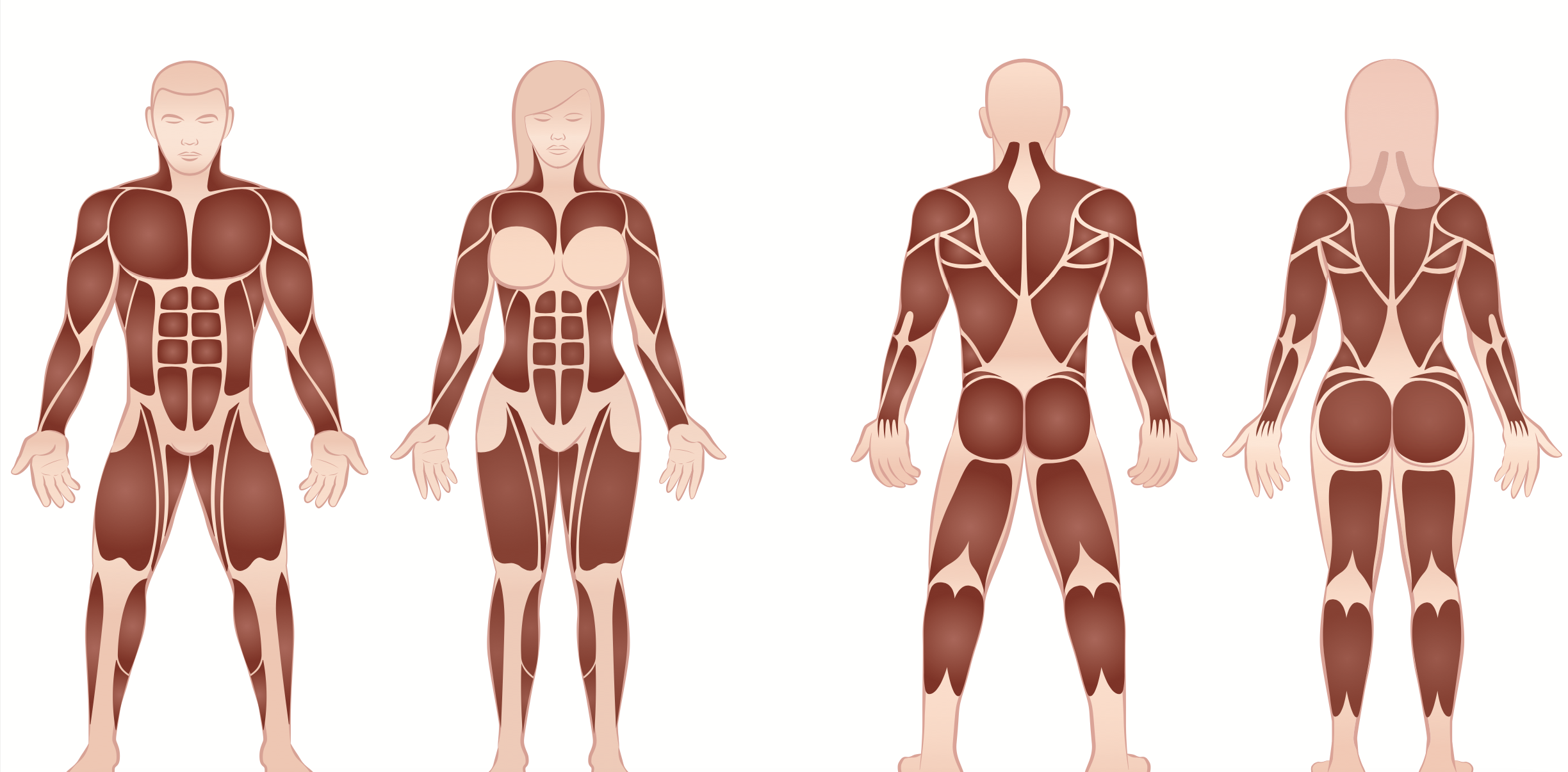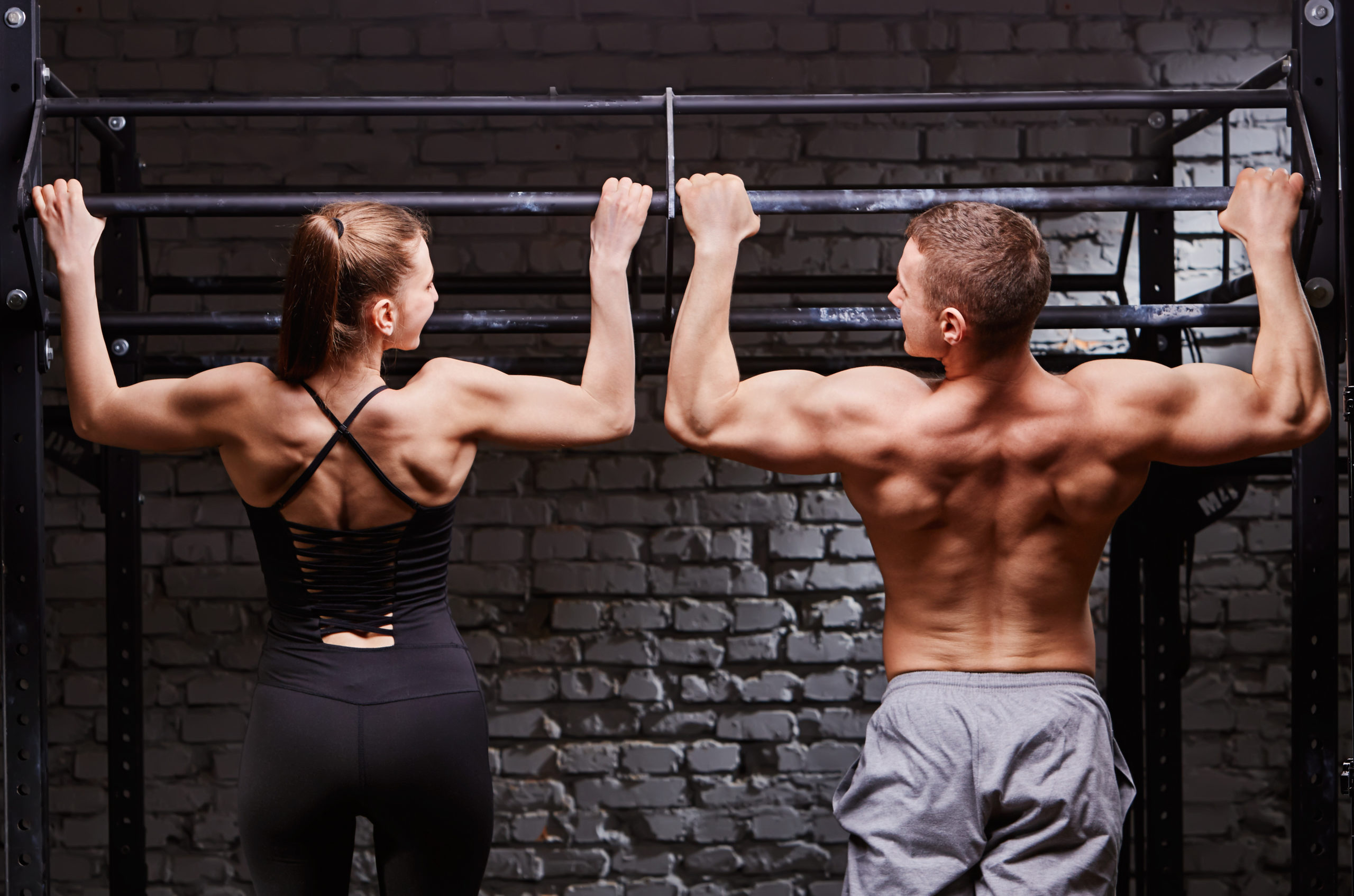
Men and women are built similarly in many ways, yet there are some fundamental differences between the two sexes. Especially on a physical and hormonal level. Men naturally have higher testosterone levels, and are therefore usually faster, stronger and bigger. But at the same time, our connective tissues, nerves, and bones are built in the same way. Most importantly, we are all different on an individual level and should tailor our training in this way too. We will explain in more detail why men and women should not train differently.
There definitely are some distinctive differences between men and women, and we are going to explore them. There are no specific man or woman exercises, but rather, some women might want to have a little different approach in their programming.
For instance, a lot of women do not want bigger chest muscles (not boobs), whereas plenty of men want exactly that.
Often, women are also scared of working out similar to men in the fear of becoming big. This is a complete myth.
In this article, we will first go over some biological differences between men and women with regard to training. Afterward, we will answer three frequently asked questions we receive from women.
Biological Differences in Men and Women

Just from observation, we can all agree that most men and women have some distinctive differences, especially in size and strength. We will point out a few differences that you might keep in mind when planning your training goals.
Hypertrophy Differences
Studies have shown that men and women experience relatively similar gains in terms of strength, when doing the same training program.
However, women tend to experience less muscle hypertrophy (muscle growth) compared to men.
This is because women have a naturally higher percentage of fat, and men have naturally higher testosterone levels (Lewis et al., 1986). Means, that women are weaker and smaller in muscle size compared to an equally trained man (Bartolomei et al., 2021).
Does this matter to you? Not really, and you probably already knew this. Even though there are certain outliers, like very small men and very large women.
But it can be comfortable to have this in mind, in case you workout with a man, and you are doing the same program.
If you experience different results, nothing is wrong, we are just all built differently!
Hamstring and Quadriceps Comparison
Another common difference in most men and women is the size of hamstring and quadriceps femoris (quads).
Men are hamstring dominant, while women are quad dominant (Youdas et al., 2007).
Do not mistake hamstrings for gluteus maximus, or the butt as we know it. Even though these muscles are connected, we are specifically talking about the hamstrings. And we are talking on average, every individual is different, and that is important to remember.
With this in mind, most women probably want to focus on working the hamstrings more than the quads. While men might focus a little more on quads. However, after training for a while these will balance out and require a similar amount of training.
Again, this is very individual-dependent not only on your physical genetics, but your goals as well.
In addition, this might help explain why as a man it is easier for you to grow and target your hamstring muscles. For women, it might be easier to grow and hit the quadriceps. Still, it is important for you to learn about your own body, and maybe as a woman, you have bigger hamstrings than your man does! Hence, why men and women should not train differently based on averages.
Difference in Upper Body Musculature

Along with a size difference in quads and hamstrings, there is a difference in lean mass of the upper body.
Most men have more lean muscle mass in the upper body compared to women.
We can spot that easily in this day and age, with those big butts and slim upper bodies running around (joking). Thus, it makes upper body exercises like push-ups and pull-ups more difficult for women. Hence, why women might want to focus on improving size and strength in their upper bodies more than men.
Do you wonder why your man so easily does more pull-ups than you? Well, now you know!
Differences in Fast vs. Slow Paced Workouts
From a biological perspective, women are naturally more adept at faster-paced workouts. More specifically, fast-paced and not so heavy, rather more intense. They also tend to recover faster from them. On the other hand, men are better at heavier, slower workouts. This does not mean you should focus more on one or the other, we are just pointing out the biological differences.
The reason for this is that men have more muscle mass, a bigger heart and a larger lung capacity than the average woman. Thus, men can pump out a higher volume of blood than women in a given workout.
This means, men can pump out more power into each workout compared to women. Thus, they need more time to recover for each set. Therefore women might be able to endure higher volumes of work within a given workout. This doesn’t mean men cannot tolerate the same amount of work because their bodies are worse.
It simply means men are able to push out more energy than women at a given time, and therefore need more time to recover.
Why Men and Women Should Not Train Differently
 We have given you the facts about these biological differences for your own insight and understanding. This does not mean that programs should be different based on gender.
We have given you the facts about these biological differences for your own insight and understanding. This does not mean that programs should be different based on gender.
Each workout plan and nutrition plan should be adjusted on an individual basis. Because each and every single one of us are different.
However, knowing these differences, it gives us more understanding. And if we look at bodybuilding competitions, for instance, we see a difference in judging. For bikini competitors, the main muscles of focus are the glutes, upper back, and shoulders.
Therefore a woman who is competing in a bikini show might want to focus on these muscles. Whereas in Men’s Physique the whole upper body is of high importance.
So the short answer is no. Men and women should not necessarily train differently. Working out our bodies is a very individual journey that has to be specified to every single individual. Not only based on their goals, but the physical structure, psychological well-being, food tolerance, lifestyle, and so on.
Should You Workout With a UTI?
 The first out of three questions is about urinary tract infections (UTI). UTIs are much more common in women than in men. UTIs are often thought to be something only women have, but men do experience them as well in some cases.
The first out of three questions is about urinary tract infections (UTI). UTIs are much more common in women than in men. UTIs are often thought to be something only women have, but men do experience them as well in some cases.
As much as one-third of women have a UTI before they turn 24, and is therefore not uncommon at all (Jaworski; Rygiel, 2019).
UTI infections have various degrees, as some are more brutal than others. If you notice it quickly and start medication right away, most exercise will not hamper recovery. However, if this is a more serious case, you might want to wait to introduce training until you have treated it with antibiotics.
This should be judged on a case-by-case basis, and how you feel. The pain can be incredible, and if the infection is bad, sweating and putting pressure around the area only make it worse.
Should Pregnant Women Workout?
In most cases, working out is great for both the baby and the mother. However, before you begin exercises, consult with your doctor first.
You might have certain complications that can be worsened if you work out.
Some of these include heart and lung disease, cervical issues, high amounts of bleeding, and anemia.
Depending on your fitness levels and health, at least 30 minutes of moderate-intensity exercise a day is a great place to begin. Aerobic activities like walking, swimming, and biking are good places to start. These exercises won’t put too much strain on your joints.
Strength training is also performed without any issues by many pregnant women and can be a great choice of exercise.
But like with everything, it is important that you consider this on an individual basis. Work together with your health provider to see how you can keep you and your baby safe and healthy.
What we can confidently say is that it is extremely important to stay hydrated. Additionally, be careful with going too hard and overheating.
Do Women Need to Workout Chest?
If you train your back, legs, shoulder, abs, and arms, you should definitely train your chest as well.
Many women are scared that their chest muscles are going to grow and look “manly.” Or even lose their boobs. This is just a myth.
By throwing out your chest workouts you risk developing muscular imbalances, which can affect your posture and ability to perform exercises that include chest muscles. Thus, leading to strains and other injuries.
We promise, that your chest will not look “manly” unless you juice up with hormones and do hardcore chest exercises.
Nonetheless, this does not mean you have to train your chest as much as your back or glutes, but throwing in a few chest exercises a week will only do you good. Some dumbbell presses and cable/machine flies will be sufficient to train the chest in both the lengthened and shortened position.
So yes, definitely remember to train your chest!
Conclusion
We have discovered a few biological differences between men and women in regards to training. These include a difference in musculature, hypertrophy, and the amount of power output in a given workout. Where we see men usually have more muscle mass, a larger heart, and a higher lung capacity. But this does not mean both sexes cannot do the same workout. Clearly, we can take away that women should not train differently from men.
The truth is, each and every individual’s personal goal is of most importance. Whether you want to compete in a bikini or strength competition, grow your calves or butt, improve your conditioning, or simply enjoy your time in the gym safely and confidently. Train however you feel is most enjoyable and optimal for your goals, with your lifestyle in mind.
Thank you for reading our article!
– Terry Asher
Terry Asher
Latest posts by Terry Asher (see all)
- Better Family – Product Review Liquid Daily 2 oz - Dec 16, 2024
- Post-Workout Recovery: The Key to Optimal Performance - Nov 25, 2024
- Pre-Workout Supplements – Everything You Need To Know - Nov 18, 2024











[…] Source link […]
[…] muscle group. One exercise can be enough depending on how you program it. Moreover, our aim is to train a lot of different muscle groups within a short period of […]